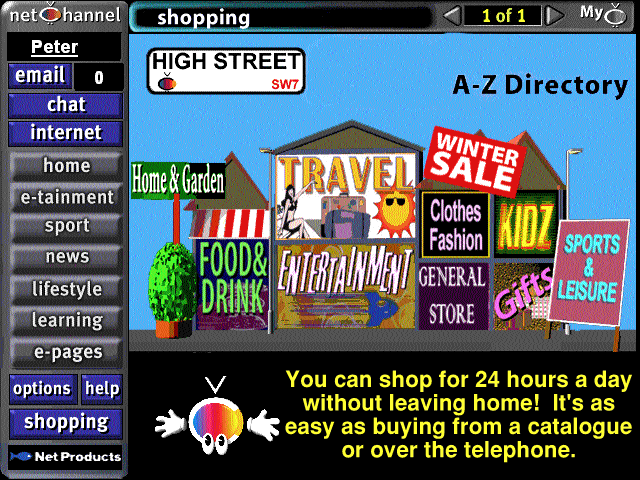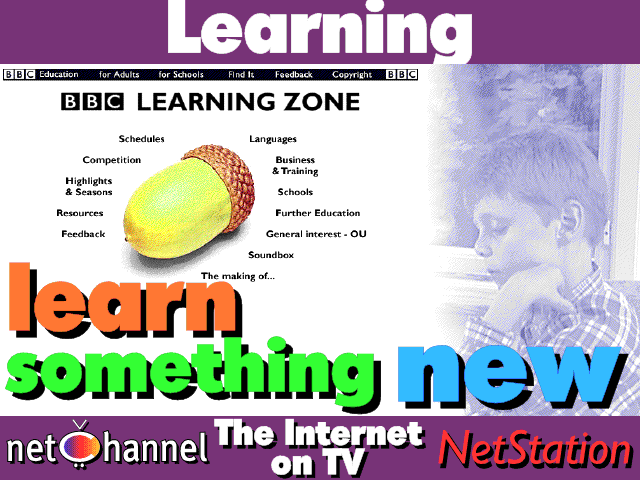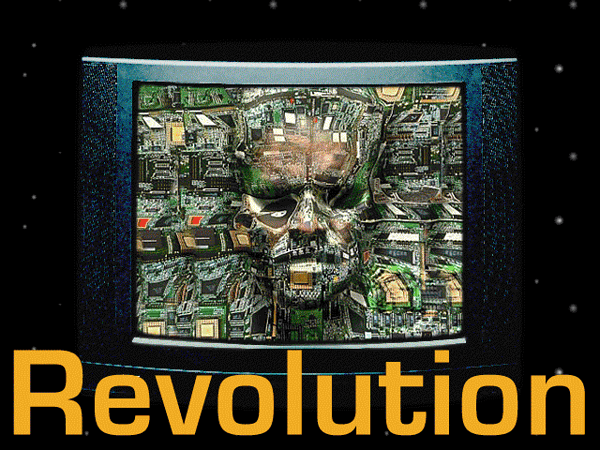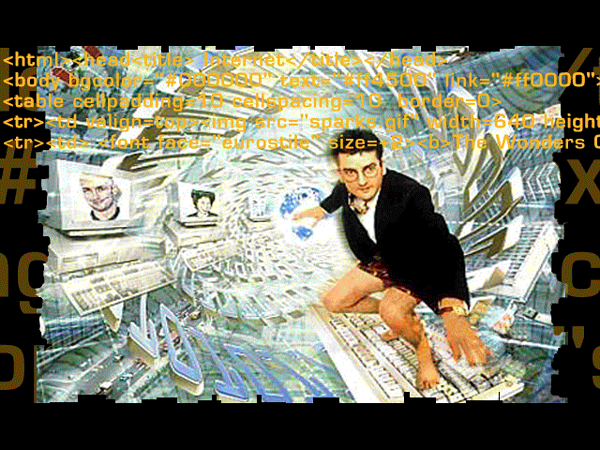NC demo system (1997)
A thin client-based slide show system for advertising displays.
This was basically an advertising system for NetChannel network computers, which was used in Harrods, Scottish Power, Dixons etc. It took a series of pre-generated slides as image files, and with clever use of timing could give the illusion of animation, text appearing and so on, plus some crude wipe effects. Later versions got more complicated by the addition of navigable areas (faking browsing a web site, using either a keyboard or the NetStation remote), random paths to allow for different sections of the demo to run on subsequent run-throughs, voiceovers, and eventually video.
Interlude
This is a long story, so skip it if you just want the pretty pictures.

I was working for ArgoNet which was a fairly prominent company in Chichester. Or at least, run by people who were known - it was the kind of small town (technically a city but whatevs) where everyone seemed to know everyone else, and indeed probably went to school with them.
Anyway it was doing some kind of sponsorship or corporate hospitality thing at the Real Ale and Jazz festival. This somehow involved hiring the biggest TV they could find and running a demo on it, I guess so that it looked like an actual work thing and not an excuse to get drunk on "company dollar".
I spent the whole of Friday creating images to be used as slides. As it took the whole day, I didn't have time to write any software to display them, and I wasn't going to hang around on a Friday night. So Saturday comes, the big boss turns up at my flat on the way to pick up the enormous TV, and asks to see the slideshow.
"Oh, I haven't written the software yet," I admitted. "But don't worry, I'll get round to it." He went off to get the very expensive TV, somewhat nervous, as I grinned behind his back.
So you can guess what happened next. No of course I didn't screw it up, this is a whole page about how I wrote a demo system, obviously I pulled it off. I wrote the software in the time it took him to get the TV, deliver it to the festival, and get back to my flat. I was young and cocky, and while technically neither an illustrator nor a programmer, I could pull it off.
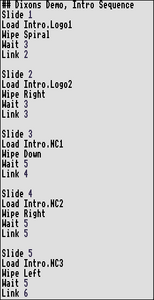
I'd actually been writing a scripting language - a simple "load file X, wait Y seconds, go to next", because I just just knew that he'd want to change the order of the files and how long certain ones appeared on screen. I thought I would need to add screen buffering - show one image while the other is loaded in the background, then switch when the load was complete so the transition looked smooth - but it turned out the system was so fast I could load the image into memory and then push it straight to the screen.
All I had to write was a simple parser and a couple of lines that loaded images to memory and blatted them to the screen. All of the real effort had been up-front, creating the images. And yes, when he saw the finished demo he wanted the order of the images changed. I knew it!
I have vague recollections of the Real Ale and Jazz festival. Like looking at the queue for the toilets, walking all the way home through traffic, using my own toilet, and then staggering back to the festival (did I mention Chichester is not a large city?). It also seemed more Rock and Roll and bottles of lager, I mean I'm not a jazz person but I'm pretty sure I know it when I hear it. And the night ended with me wandering away with a Grolsch sticking out of every pocket. I was the only one drinking lager, so there was plenty all night - and loads left at the end. They had to open the bottles before they served it but Grolsch famously had those resealable tops and hadn't we already paid for all of that booze...?
And now the actual demo story
So fast forward to when somehow this incredibly quickly written bit of code was to be made in to a moneyspinner, because it was so good it couldn't be left alone or something? I dunno, maybe PowerPoint was in its infancy. The demo worked well on network computers (cheap thin clients) with a Zip drive attached, which our company just happened to write the drivers for and sell as a package.
A few extra features such as "wipes" were added. Transparency was beyond what the system could do - or at least my command over it - but simple transitions I could handle. The whole demo was written in BBC BASIC - BASIC is as simple to program as the name implies, but the "BBC" (Acorn) version has access to incredibly powerful system calls for things like file handling and sprite manipulation.
For instance, you could load an image to memory, mask off most of the screen, and when you print the image it's only overwriting part of the screen. Change the mask quickly and often enough with the same memory of an image, and you can fake a wipe - simple up, down, left and right were just a loop away. Diagonal and spiral wipes are trickier as the area had to be rectangular, but some maths to generate enough small boxes in just the right order could fake it well enough.
So slides get drawn, software gets perfected, demos get made. By this point it's all me - not just the programming and design, I'm also heading up to the client's Mayfair offices (posh bit of London) to take the meetings. For someone hired to be front line tech support and occasional web/icon designer guy, this was way outside my comfort zone. The client kept wanting the software to do more and more, and I think the attitude back at the office was "well, if we can bill them for it..." Who knows, maybe it made enough money that "occasional web/icon designer guy" still had a job at the end of the year. But it was all a long way from that first simple script to trying to figure out how to fake web browsing by drawing a yellow rectangle responding to input from the remote control...
I did get to see the demo running in Harrods. I think it was only there for a week, and I happened to be in the area for a meeting with the people who were buying the demo. But it was there.
Anyway, on to the images:
NEI demo
A later demo - this one with full narration. It appears to be a demo of some new Internet-connected TVs.
The main problem with developing the version with narration was that it was basically just playing a sound file in the background, and then getting on with the business of playing slides as normal. There was no way of tying the two together so that one triggered off the other, it was all done by getting the script timing perfectly aligned. The audio couldn't be split up due to the background music, so I just had to start it at the beginning of the slide show and hope for the best.
However, image files took longer to load in from a Zip drive on a thin client than they did on a "proper" computer with a hard drive.
I'd play the sequence over and over on the computer, adjusting the timing of the image "pauses" by hand, until slides appeared exactly on cue - only to find it slipped out of sync when I tried to demo it on the actual hardware. I quickly worked out that it was out by a fixed amount, so I could just detect what hardware it was playing on and apply a multiplier to speed up or slow down the slide show as required. Otherwise I think I would have driven myself mad.
I managed to record this as a video (above), but here's a transcript. I had to put in another set of pauses of about two thirds of a second to emulate the old loading times to get it anywhere near synced.
We are on the cusp of the greatest revolution in consumer electronics since television itself.
The Internet is no longer just a playground for academics and computer hackers. It will impact on every aspect of life. By 2002, 43% of British homes will be online, with 9.8 million households wired for digital news and entertainment.
POLYVISION represents a uniquely attractive package to these new customers.
Look at what it includes: the UK's first SRS TV with with full 3D sound. A superb 28" screen AND picture in picture.The house of the future - a video camera with automatic sensors to monitor the front door, the kids in the garden or the baby's bedroom.
And Polyvision's unique software to access the wonders of the Internet through YOUR television. It's like teletext, only a million times more powerful!
From your armchair you can catch up on the news, get the latest stock market prices, pick up a recipe, visit your favourite football club, email a friend, shop and bank around the globe, and around the clock. Or visit any of the millions of websites around the world.
Polyvision, the most advanced TV package on the planet, gives you the world at your fingertips. A window - on the future!

